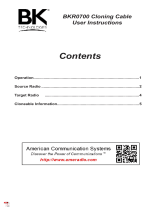
Encryption Key (Encrypted Radios Only) ................................................19
Key Selection Setting (Encrypted Digital Radios Only)...........................20
Channel Label .........................................................................................20
Review Channel Settings ........................................................................21
Program Another Channel .......................................................................21
Exit Programming Mode ..........................................................................21
COMMAND (CMD) RADIO KEYPAD PROGRAMMING .................22
Group Parameters (CH 00) .....................................................................22
Channel Parameters................................................................................22
Global Parameters (GRP 00) ..................................................................22
NAVIGATION ...................................................................................23
Selecting Group Parameters ...................................................................23
Selecting Channel Parameters ................................................................23
Selecting Global Parameters ...................................................................23
Editing Parameters ..................................................................................24
CMD GROUP PARAMETERS (CH 00) ...........................................24
Group Options Group One: 1-12345678 .................................................25
CMD GLOBAL PARAMETER OPTIONS (GRP 00) ........................26
Keypad Editing Password........................................................................26
Global Option Groups 1 and 2 .................................................................26
Global Options Group One.................................................................26
Global Options Group Two .................................................................28
Automatic Number Identication ID (ANI)................................................29
Priority 1 Channel ....................................................................................30
Priority 1 Group .......................................................................................30
Priority 2 Channel ....................................................................................31
Priority 2 Group .......................................................................................31
Transmit on Priority 1 ..............................................................................31
Priority 1 Lock ..........................................................................................32
Scan List Lock .........................................................................................32
Transmit Time-out Timer ..........................................................................32
Scan Delay .............................................................................................33
Busy Channel Operation .........................................................................33
ANI/DTMF Operation ...............................................................................33
Backlight Option ......................................................................................34
Backlight Duration ...................................................................................35
Silent Mode..............................................................................................35
Battery Save ............................................................................................35























